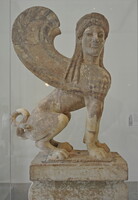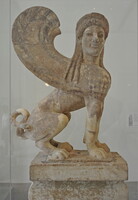| dc.coverage.spatial | Site: Metropolitan Museum of Art (New York, New York, United States) 11.185d, x | en_US |
| dc.coverage.temporal | ca. 530 BCE (creation) | en_US |
| dc.creator | unknown (Greek (ancient)) | en_US |
| dc.date | -530--520 | en_US |
| dc.date.accessioned | 2016-08-23T18:14:11Z | |
| dc.date.available | 2016-08-23T18:14:11Z | |
| dc.date.issued | -530--520 | en_US |
| dc.identifier | 268070 | en_US |
| dc.identifier.other | archrefid: 3453 | en_US |
| dc.identifier.uri | http://hdl.handle.net/1721.3/184376 | |
| dc.description | Overall view (original, removed from top of stele and displayed eye level); This capital and sphinx originally crowned the tall grave marker of a youth and a little girl (MMA accession number 11.185a-d, f, g, x). It is displayed separately at viewer level and a plaster copy is now set on top of the stele. The Greeks represented the sphinx as a winged female and often placed its image on grave monuments as guardian of the dead. This sphinx, which retains abundant traces of red, black, and blue pigment, was carved separately from the capital on which it stands. Source: Metropolitan Museum of Art [website]; http://www.metmuseum.org (accessed 8/17/2015) | en_US |
| dc.format.medium | Parian marble | en_US |
| dc.rights | © Scott Gilchrist, Archivision, Inc. | en_US |
| dc.subject | death or burial | en_US |
| dc.subject | funerary art | en_US |
| dc.subject | mythology (Classical) | en_US |
| dc.subject | mythical creatures | en_US |
| dc.subject | Archaic (Greek) | en_US |
| dc.title | Marble capital and finial in the form of a sphinx | en_US |
| dc.type | image | en_US |
| dc.rights.access | Licensed for educational and research use by the MIT community only | en_US |
| dc.identifier.vendorcode | 7A3-MMA-G-MCS-A01 | en_US |
| vra.culturalContext | Ancient Greek | en_US |
| vra.technique | carving (processes) | en_US |
| vra.worktype | capital (column component) | en_US |
| dc.contributor.display | unknown (Greek (ancient)) | en_US |


